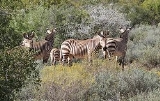
Cape Mountain Zebra
Encyclopedia
Cape mountain zebra, Equus zebra zebra, is a subspecies
of the Mountain zebra
found in the Western
and Eastern Cape
in South Africa
. They mainly eat grass but if little food is left they will eat bushes. It has been argued that it should be considered a separate species than the Hartmann's Mountain Zebra
, but this is not supported by genetic
evidence (see Taxonomy of the Mountain zebra). Consequently, it was "only" considered a subspecies in Mammal Species of the World
.
Eleven animals were donated from a nearby farm in 1950, and in 1964 another small herd was added. By the late 1960s, the total Cape mountain population was only 140 but grew to 200 by 1979, with 75 percent of the animals in Mountain Zebra National Park . In 1984, the population was back to 400 head. Since then a few zebras have been reintroduced to the Cape Point
Section of Table Mountain National Park
.
Subspecies
Subspecies in biological classification, is either a taxonomic rank subordinate to species, ora taxonomic unit in that rank . A subspecies cannot be recognized in isolation: a species will either be recognized as having no subspecies at all or two or more, never just one...
of the Mountain zebra
Mountain Zebra
The Mountain Zebra, Equus zebra, is a threatened species of equid native to south-western Angola, Namibia and South Africa. It has two subspecies, the Cape Mountain Zebra and Hartmann's Mountain Zebra , though it has been suggested these should be considered separate species.-Taxonomy:In 2004,...
found in the Western
Western Cape
The Western Cape is a province in the south west of South Africa. The capital is Cape Town. Prior to 1994, the region that now forms the Western Cape was part of the much larger Cape Province...
and Eastern Cape
Eastern Cape
The Eastern Cape is a province of South Africa. Its capital is Bhisho, but its two largest cities are Port Elizabeth and East London. It was formed in 1994 out of the "independent" Xhosa homelands of Transkei and Ciskei, together with the eastern portion of the Cape Province...
in South Africa
South Africa
The Republic of South Africa is a country in southern Africa. Located at the southern tip of Africa, it is divided into nine provinces, with of coastline on the Atlantic and Indian oceans...
. They mainly eat grass but if little food is left they will eat bushes. It has been argued that it should be considered a separate species than the Hartmann's Mountain Zebra
Hartmann's Mountain Zebra
Hartmann's mountain zebra, Equus zebra hartmannae, is a subspecies of the mountain zebra found in far south-western Angola and western Namibia.Hartmann's mountain zebras prefer to live in small groups of 7-12 individuals...
, but this is not supported by genetic
Genetics
Genetics , a discipline of biology, is the science of genes, heredity, and variation in living organisms....
evidence (see Taxonomy of the Mountain zebra). Consequently, it was "only" considered a subspecies in Mammal Species of the World
Mammal Species of the World
Mammal Species of the World, now in its 3rd edition, is a standard reference work in zoology giving descriptions and bibliographic data for the known species of mammals.An updated Third Edition of Mammal Species of the World was published late in 2005:...
.
Social behaviour
Mountain Zebras associate in small groups. Two types of groups can be distinguished, namely family groups and bachelor groups. A family group consists of a mature stallion and between one and five mares (usually two or three) and their offspring. Those stallions that cannot obtain mares associate in loose bachelor groups. The members of a family group normally stay together for many years. One stallion in the Mountain Zebra National Park, born in 1959, established himself as a herd stallion in 1965 and was still with the same mares' fifteen years later. http://www.kwagga.de/zebra/zebra1_e.htmAppearance
Its broad black stripes are closely spaced on a pure white body. Overall it is stockier than the Hartmann's zebra, has longer ears, and has a larger dewlap.Prevention of extinction
The Cape mountain zebra formerly inhabited all the mountain ranges of the southern Cape Province of South Africa. By 1922, however, only 400 were believed to survive. http://www.wild-about-you.com/GameCapeMountainZebra.htm To counteract the continued decline, Mountain Zebra National Park was established in 1937 http://www.nature-reserve.co.za/mountain-zebra-national-park.html on acacia veld near Cradock, South Africa, but its small population of Cape mountain zebra became extinct in 1950. That same year reintroductions from nearby remnant populations began.Eleven animals were donated from a nearby farm in 1950, and in 1964 another small herd was added. By the late 1960s, the total Cape mountain population was only 140 but grew to 200 by 1979, with 75 percent of the animals in Mountain Zebra National Park . In 1984, the population was back to 400 head. Since then a few zebras have been reintroduced to the Cape Point
Cape Point
Cape Point is a promontory at the southeast corner of the Cape Peninsula, which is a mountainous and scenic landform that runs north-south for about thirty kilometres at the extreme southwestern tip of the African continent in the Republic of South Africa. Table Mountain and the city of Cape Town...
Section of Table Mountain National Park
Table Mountain National Park
Table Mountain National Park, previously known as the Cape Peninsula National Park, is a national park in Cape Town, South Africa, proclaimed on May 29, 1998, for the purpose of protecting the natural environment of the Table Mountain Chain, and in particular the rare fynbos vegetation...
.

